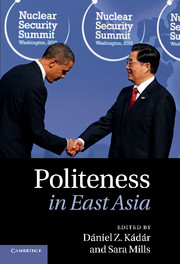Book contents
- Frontmatter
- Contents
- Notes on contributors
- Foreword
- Acknowledgements
- Abbreviations
- 1 Introduction
- Part I Politeness in East Asia: Theory
- Part II Politeness in East Asia: Practice
- 6 Politeness in China
- 7 Politeness in Japan
- 8 Politeness in Korea
- 9 Politeness in Vietnam
- 10 Politeness in Singapore
- 11 Epilogue: Culture and norms in politeness research
- Notes
- Bibliography
- Index
8 - Politeness in Korea
from Part II - Politeness in East Asia: Practice
Published online by Cambridge University Press: 07 September 2011
- Frontmatter
- Contents
- Notes on contributors
- Foreword
- Acknowledgements
- Abbreviations
- 1 Introduction
- Part I Politeness in East Asia: Theory
- Part II Politeness in East Asia: Practice
- 6 Politeness in China
- 7 Politeness in Japan
- 8 Politeness in Korea
- 9 Politeness in Vietnam
- 10 Politeness in Singapore
- 11 Epilogue: Culture and norms in politeness research
- Notes
- Bibliography
- Index
Summary
General politeness phenomena in Korea is a topic which requires much more space than any single chapter can limit its discussion to. Interestingly, native speakers of Korean may conceive the notion of ‘politeness’ as a concept that is intricately associated with a linguistic entity known as ‘honorifics’ – a system that encodes one's deference towards speaking partners who are viewed as superior in age or in social standing. A Korean speaker will translate the English word politeness as yey'ui-palu-m 예의(禮儀)바름 ‘to be deferential’, or kongson-ha-m 공손(恭遜)함 ‘to be deferential/to be reverent’. In other words, native Korean speakers appear to perceive the notion of ‘politeness’ largely through honorification, and they take the absence of honorification of a superior naturally as the lack of politeness, that is, rudeness with respect to such a person. This occurs in Japanese as well, as shown in Ide and Yoshida (1999: 461), where the Japanese adjective teineina 丁寧な – the Japanese approximation of the English ‘polite’ – has a strong association with notions such as keii no aru 敬意のある ‘ with deference or respectful’ and tekisetuna 適切な ‘appropriate’. In this chapter, therefore, an effort will be made to isolate the notion of politeness from honorific expressions. At the same time, the chapter will examine the system of Korean honorifics itself because of its critical association with politeness phenomena in the Korean language. How to be polite to others is primarily reflected in adherence to honorifics in Korea, where (Neo-)Confucian doctrines prevailed in various aspects of people's living through two dynasties (for some 1,000 years from 912 to 1910) before the late nineteenth- and the early twentieth-century modernisation, particularly during the dynasty of Chosŏn (1392–1910). The chapter also discusses a strong trend towards reducing the use of honorifics among modern speakers, notwithstanding vigorous campaigns for preserving the honorific system, which conservative educators regard as a sacred marvel of the Korean language. This chapter will delve into one of the multiple speech styles known as panmal (반말 ‘half-speech’), which may have developed into a subsystem recognisable in the honorific system during the later part of the Chosŏn Dynasty or most probably during the breakdown of the aristocratic society of the Yangban ruling class. The phenomenon of panmal is particularly significant in this chapter because of its unique implications for the pragmatic aspect of honorific theory. The chapter will also deal with some intriguing hypercorrection phenomena brought about by the ubiquitous tides of modern commercialism. In the study of politeness in the Korean language, a researcher immediately encounters difficulty in distinguishing between the notion of politeness and that of honorifics. The two notions are intertwined and interconnected in Korean and in most cases they are treated as a single entity without clear distinction between the two concepts. Some traditional Korean linguists would argue that the notion of politeness developed in the work of Goffman (1955) and Brown and Levinson (1978, 1987) has no place in the study of Korean politeness, since Korean has a system of honorifics that is comprehensive enough to account for any aspects of polite expressions in Korean. Such a traditional view notably emphasises the fundamental cultural difference between Korean society and that of the West, arguing that theories based on the notion of politeness are hardly capable of capturing the culturally ingrained Korean politeness in general. We find a similar view in works like Matsumoto (1988) and Ide (1989) with Japanese data. As we see in the following discussions, such a general view is attributed to the ambivalent understanding of the notions of politeness and honorifics. The system of honorifics has been studied within Korea since the turn of the last century.
- Type
- Chapter
- Information
- Politeness in East Asia , pp. 176 - 207Publisher: Cambridge University PressPrint publication year: 2011
- 11
- Cited by

